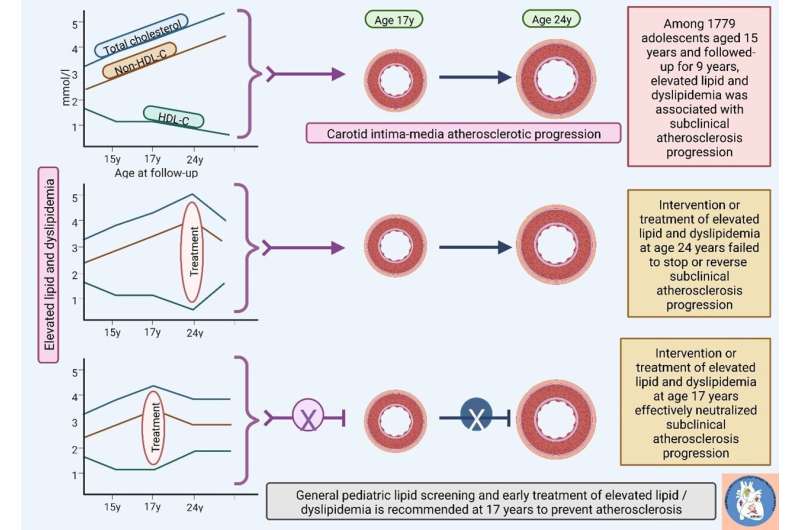Atherosclerosis progression could be stopped if lipid screening and dyslipidemia intervention begin in adolescence

Consistently elevated lipids and dyslipidemia in early life were associated with worsening subclinical atherosclerosis, but simulated lipid treatment in late adolescence stopped atherosclerosis progression, a paper published in Atherosclerosis concludes. The study was conducted in collaboration between Northwestern University in the U.S., Baker Heart and Diabetes Research Institute in Australia, the University of Bristol in the U.K., the University of Turku in Finland, and the University of Eastern Finland.
Abnormal blood cholesterol and triglyceride levels known as elevated lipids and dyslipidemia are major causes of atherosclerosis where cholesterol plaques are deposited within the blood vessels. There is yet no consensus on screening children and adolescents for elevated lipids and dyslipidemia in the general population.
Evidence suggests that children and adolescents who have inherited lipid disorders do well with treatments when commenced early. However, whether elevated lipid and dyslipidemia lead to early cardiovascular damage before mid-adulthood in a large asymptomatic adolescent population is not known.
The current study, conducted among 1,779 adolescents who were 15 years old and followed up for nine years until 24 years of age, revealed that almost 1 in 5 adolescents had elevated lipids or dyslipidemia at age 15 years. The prevalence of elevated lipids and dyslipidemia increased to 1 in 4 young adults, nine years later. Importantly, only 1 in 1,000 adolescents had received treatment for dyslipidemia at the age 17-year follow-up. This leaves more than 440 adolescents with untreated elevated lipids and dyslipidemia.
The researchers found that among these 440 asymptomatic adolescents, signs of subclinical atherosclerosis were evident and the disease unfortunately was already worsening. According to the researchers, this is worrisome as almost all adolescents with the potential risk of cardiovascular disease largely escape early life screening and treatment.
Since clinical trials on the effect of lipid treatment on cardiovascular diseases are rare in asymptomatic children and adolescents, the researchers developed a novel model to simulate a clinical trial intervention. The novel Temporal Inverse Allocation Model involved treatment intervention at a specific age or follow-up time, after which the researchers analyzed whether that treatment stopped worsening atherosclerosis progression.
To their surprise, the researchers observed that lipid treatment intervention at the age of 24 years failed to stop worsening atherosclerosis. This suggests that treatment in early adulthood may be too late to offer optimal cardiovascular health benefits. Importantly, lipid treatment intervention at the age of 17 years effectively stopped and reversed atherosclerosis progression.
This study is a critical piece of evidence for the general population's cardiovascular health and emphasizes the need for early-life screening and prevention of elevated lipids and dyslipidemia from a young age.
"We need not wait until we're in our 40s to have our cholesterol levels checked. A high total cholesterol level and low HDL level damaged the vascular wall as early as adolescence and if not treated early, we might miss a golden opportunity for better cardiovascular health," says Andrew Agbaje, a physician and clinical epidemiologist at the University of Eastern Finland.
Treatment of atherosclerosis at a later stage is expensive, tedious, and complicated with often unsatisfactory results. "Atherosclerosis stealthily progresses with time and the earliest possible intervention may offer the opportunity to truncate the disease's progression."
"It is important to note that in this study, high total cholesterol, high non-HDL-cholesterol, and a very low HDL level were associated with signs of atherosclerosis, even in normal-weight adolescents. Interestingly, elevated LDL-cholesterol and triglyceride may not yet pose a problem in this age group, especially if there is no genetic inheritance of lipid diseases."
"These novel findings should change our approach to atherosclerosis prevention. Public health experts, pediatricians, and government health policymakers should consider lipid screening in adolescence and initiating treatment for high cholesterol and low HDL by age 17 years. Regarding primary prevention of atherosclerosis, the food we eat from early life could either be poison to our blood vessels or an antidote for atherosclerosis, the choice is ours," says Andrew Agbaje.
More information: Andrew O. Agbaje et al, Cumulative dyslipidemia with arterial stiffness and carotid IMT progression in asymptomatic adolescents: A simulated intervention longitudinal study using temporal inverse allocation model, Atherosclerosis (2022). DOI: 10.1016/j.atherosclerosis.2022.11.011




















